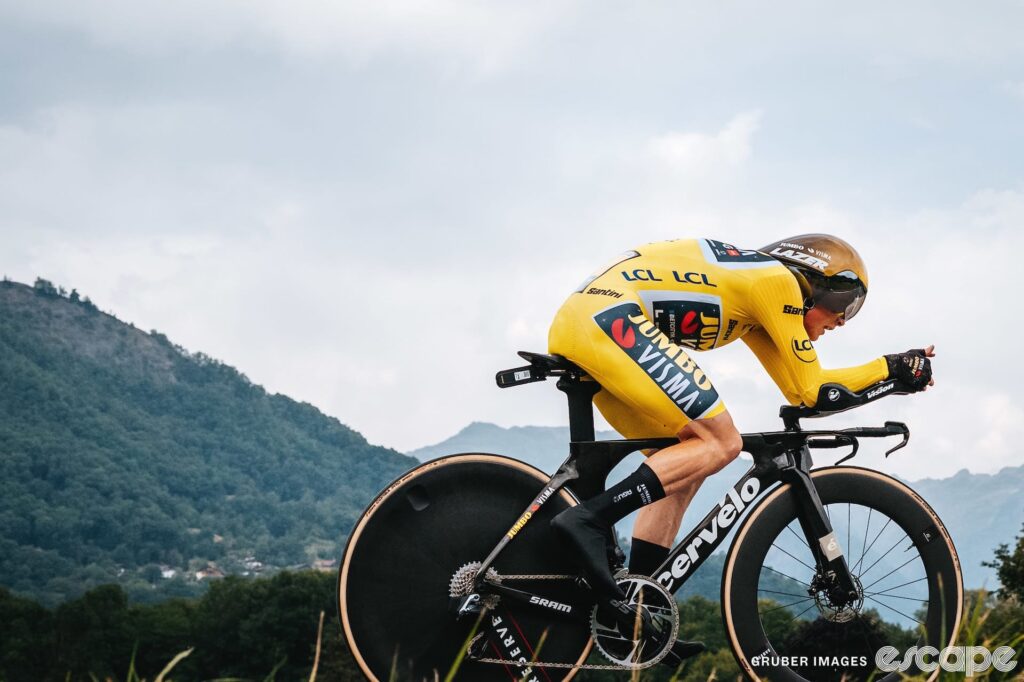
The Tour de France has long been a battleground where watts, willpower, and endurance are tested to their limits. Yet, the modern era of cycling has introduced a new layer of complexity to this iconic race. As the 2023 Tour de France approaches its much-anticipated Stage 13, a mountain time trial, the focus shifts from sheer physical strength to the nuanced art of equipment optimization.
In this stage, the choice of a time trial (TT) bike is expected to be the fastest option, but intriguingly, it may only benefit two riders: Jonas Vingegaard and Tadej Pogačar. Meanwhile, the use of a front disc wheel, although optimal in theory, is unlikely to be seen. This development underscores the intricate balance between aerodynamics and weight, especially on a course that challenges both.
The Complexities of Modern Time Trials
Once a straightforward contest of speed and stamina, time trials in the Tour de France have evolved into a sophisticated interplay of technology and strategy. The introduction of advanced equipment and meticulous planning has transformed these stages into a chess game on wheels. Despite the apparent simplicity of a mountain time trial, where gravity seems to favor raw power, the reality is far more intricate.
As the road inclines and speeds decrease, one might assume aerodynamics become less critical. However, given the high velocities at which general classification (GC) contenders now climb, aerodynamic efficiency remains paramount. This year’s Stage 13 is not just another mountain time trial; it represents one of the most challenging equipment puzzles for performance engineers throughout the Tour.
Equipment Choices and Their Impact
The outcome of Stage 13 will hinge on a myriad of equipment decisions, each with its own set of trade-offs. From the selection of skinsuits and socks to the choice between a lightweight road bike with aerodynamic modifications or a full TT setup, every detail contributes to a rider’s performance. The stage begins with a flat 3 km section, where aerodynamics play a crucial role, followed by a grueling 8% climb, where weight becomes the dominant factor.
These decisions are not merely academic; they directly influence the rider’s ability to maximize their potential. The delicate balance between aerodynamic efficiency and weight savings is a testament to the complexity of modern cycling.
The Riders and Their Strategies
Stage 13 is expected to be a showdown between two of the sport’s titans: Jonas Vingegaard and Tadej Pogačar. Both riders have demonstrated exceptional prowess in time trials, but the unique demands of this stage will test their teams’ strategic acumen. The choice of equipment could very well tip the scales in favor of one rider over the other.
While the focus often falls on the riders themselves, it is the behind-the-scenes work of engineers and strategists that can make or break a performance. The decision to forgo a front disc wheel, despite its aerodynamic advantages, highlights the nuanced considerations that teams must weigh.
Expert Opinions and Historical Context
According to cycling analyst Dr. Michael Hutchinson, “The mountain time trial is a unique beast. It requires a blend of power, precision, and planning that few stages can match. The equipment choices are as much about managing the rider’s energy as they are about cutting through the air.”
“The mountain time trial is a unique beast. It requires a blend of power, precision, and planning that few stages can match.” – Dr. Michael Hutchinson
Historically, mountain time trials have been pivotal in determining the overall winner of the Tour. The 1989 Tour de France, for instance, was famously decided by a mere eight seconds, underscoring the importance of every decision made in these stages.
Looking Ahead: Implications for the Tour
As the riders prepare for Stage 13, the implications of their equipment choices extend beyond this single stage. The decisions made here could influence team strategies for the remainder of the Tour, setting the tone for the final push towards Paris.
The Tour de France remains a dynamic and evolving spectacle, where innovation and tradition coexist. As teams continue to push the boundaries of what is possible, the mountain time trial serves as a reminder of the sport’s enduring complexity and allure.
With the eyes of the world on the Tour, Stage 13 promises to be a captivating display of skill, strategy, and the relentless pursuit of excellence. As the riders take to the course, the world will watch, eager to see who will emerge victorious in this intricate dance of man and machine.






